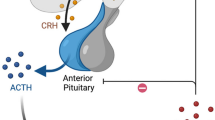Opinion statement
Infantile spasms are associated with a diverse range of conditions, and treatment options are available. However, outcomes remain generally poor, particularly for those with symptomatic etiologies. First-line therapy is considered to be hormonal (adrenocorticotropic hormone; ACTH), which some evidence suggests is more effective when started early. However, side effects may place limits on its use acutely and long-term. There is additional evidence for vigabatrin, specifically for infantile spasms secondary to tuberous sclerosis complex. In refractory cases, candidacy for surgical management should be explored, along with new-generation anticonvulsants (eg, topiramate, zonisamide) and the ketogenic diet. There is urgent need for further treatment trials comparing anticonvulsants with ACTH and a satisfactory animal model for the study of spasms.
Similar content being viewed by others
References and Recommended Reading
West WJ: On a peculiar form of infantile convulsions. Lancet 1841, i:724–735.
Niedermeyer E, Lopes da Silva FH: Electroencephalography: Basic Principles, Clinical Applications, and Related Fields, edn 5. Baltimore, MD: Lippincott Williams & Wilkins; 2005:538–542.
Hrachovy RA, Frost JD Jr: Infantile epileptic encephalopathy with hypsarrhythmia (infantile spasms/West syndrome). J Clin Neurophysiol 2003, 20:408–425. Historical and clinical overview of IS.
Frost JD, Hrachovy RA: Pathogenesis of infantile spasms: a model based on developmental desynchronization. J Clin Neurophysiol 2005, 22:25–36. This article reviews the known pathogenesis of IS, with attention to a model of temporal desynchronization of brain maturation caused by at least two brain insults.
Mikati MA, Lepejian GA, Holmes GL: Medical treatment of patients with infantile spasms. Clin Neuropharmacol 2002, 25:61–70.
Lado FA, Moshe SL: Role of subcortical structures in the pathogenesis of infantile spasms: what are possible subcortical mediators? Int Rev Neurobiol 2002, 49:115–140.
Rho JM: Basic science behind the catastrophic epilepsies. Epilepsia 2004, 45(Suppl):5–11. A useful discussion of three theories on the pathogenesis of the catastrophic epilepsies.
Avanzini G, Panzica F, Franceschetti S: Brain maturational aspects relevant to pathophysiology of infantile spasms. Int Rev Neurobiol 2002, 49:353–365.
Stafstrom CE, Holmes GL: Infantile spasms: criteria for an animal model. Int Rev Neurobiol 2002, 49:391–411.
Mackay MT: Practice parameter: medical treatment of infantile spasms. Neurology 2004, 62:1668–1681. Essential evidence-based review and guidelines concerning the available data for medical treatments of IS according to the AAN.
Gupta R: Corticosteroids in the management of paediatric epilepsies. Arch Dis Child 2005, 90:279–384. A very good summary of the often conflicting studies, potential mechanisms of action, and applications of steroids in pediatric epilepsies, including spasms.
Riikonen R: The latest on infantile spasms. Curr Opin Neurol 2005, 18:91–95. An excellent review of current treatments and outcomes that incorporates the AAN review and the European literature.
Kondo Y, Okumura A, Watanabe K, et al.: Comparison of two low dose ACTH therapies for West syndrome: their efficacy and side effects. Brain Dev 2005, 27:326–330.
Wheless JW: Nonpharmacologic treatment of the catastrophic epilepsies of childhood. Epilepsia 2004, 45(Suppl):17–22. Reviews surgical treatment and use of the ketogenic diet in the catastrophic epilepsies.
Kossoff EH, Pyzik PL, McGrogan JR, et al.: Efficacy of the ketogenic diet for infantile spasms. Pediatrics 2002, 9:780–783.
Shields DW: Medical versus surgical treatment: which treatment when. Int Rev Neurobiol 2002, 49:253–267.
Riikonen R: Infantile spasms: therapy and outcome. J Child Neurol 2004, 19:401–404.
Kivity S, Lerman P, Ariel R, et al.: Long-term cognitive outcomes of a cohort of children with cryptogenic infantile spasms treated with high dose adrenocorticotropic hormone. Epilepsia 2004, 45:255–262.
Capovilla G, Beccaria F, Montagnini A, et al.: Short-term nonhormonal and nonsteroid treatment in West syndrome. Epilepsia 2003, 44:1085–1088.
Baram TZ, Mitchell WG, Tournay A, et al.: High-dose corticotropin (ACTH) versus prednisone for infantile spasms: a prospective, randomized, blinded study. Pediatrics 1996, 97:375–379.
Hrachovy RA, Frost JD Jr, Glaze DG: High-dose, longduration versus low-dose, short-duration corticotropin therapy for infantile spasms. J Pediatr 1994, 124:803–806.
Lux AL, Edwards SW, Hancock E, et al.: The United Kingdom Infantile Spasm Study comparing vigabatrin with prednisolone or tetracosactide at 14 days: a multicenter, randomised controlled trial. Lancet 2004, 364:1773–1778.
Appleton RE, Peters AC, Mumford JP, Shaw DE: Randomised, placebo-controlled study of vigabatrin as first-line treatment of infantile spasms. Epilepsia 1999, 40:1627–1633.
Spencer EL, Harding GF: Examining visual field defects in the paediatric population exposed to vigabatrin. Documenta Ophthalmologica 2003, 107:281–287.
Hosain SA, Merchant S, Solomon GE, Chutorian A: Topiramate for the treatment of infantile spasms. J Child Neurol 2006, 21:17–19.
Grosso S, Galimberti D, Farnetani MA, et al.: Efficacy and safety of topiramate in infants according to epilepsy syndromes. Seizure 2005, 14:183–189.
Hachad H, Ragueneau-Majlessi I, Levy RH: New antiepileptic drugs: review of drug interactions. Ther Drug Monit 2002, 24:91–103.
Lotze TE, Wilfong AA: Zonisamide treatment for symptomatic infantile spasms. Neurology 2004, 62:296–298.
Yanagaki S, Oguni H, Yoshii K, et al.: Zonisamide for West syndrome: a comparison of clinical responses among different titration rates. Brain Dev 2005, 27:286–290.
Fisher E, Siemes H, Pund R: Valproate metabolites in serum and urine during antiepileptic therapy in children with infantile spasms: abnormal metabolite pattern associated with reversible hepatotoxicity. Epilepsia 1992, 33:165–171.
Siemes H, Spohr HL, Michael T, Nau H: Therapy of infantile spasms with valproate: results of a prospective study. Epilepsia 1988, 29:553–560.
Author information
Authors and Affiliations
Rights and permissions
About this article
Cite this article
Overby, P.J., Kossoff, E.H. Treatment of infantile spasms. Curr Treat Options Neurol 8, 457–464 (2006). https://doi.org/10.1007/s11940-006-0035-5
Issue Date:
DOI: https://doi.org/10.1007/s11940-006-0035-5




